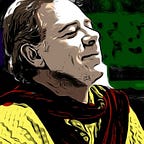I’ve been playing quite a bit with MidJourney’s AI-based image generator. With it you can generate many astounding and creative (perhaps even artistic) images, from just a textual description of what you desire to see.
While there are many issues (legal, ethical, etc.) with AI generated art, it is an amazingly powerful tool that I think is worth exploring. One aspect of concern is specifically what kind of biases are present in image generators.
So here, I explore the MidJourney’s (version 4, style 4c) definition of feminine beauty.
Experiment Design
I use a succession of prompts designed to isolate a portrait of a woman, with little in the way of a distracting background. I planned to use prompts like:
plain looking woman, portrait, white background
and then to vary the term “plain looking” with other terms like “pretty”, “ugly”, and “beautiful” (but leaving other elements of the prompt alone).
Generated Images
In my estimation, we are already off to a problematic start — with a collection of faces I could already ascribe as “models”. But, this is our baseline, such as it is.
We find these “pretty” women more heavily made up, and their hair styled more deliberately, and in more deliberate poses.
To push it further, let’s try “beautiful”:
Interestingly, the depictions are becoming more artistic and stylized, without necessarily changing the appearance of the women’s faces themselves; we are getting “beautiful portraits”, perhaps, in addition to “beautiful women”.
To progress in the direction away from beauty, we can try at first “unattractive”:
Again, this evaluation seems harsh; at best, a collection of very nice looking women without makeup.
I next wanted to test a harsher evaluation and use “ugly” as my prompt:
Wow. We get immediately into a realm of age bias. Old people are ugly people (according to the AI). To counteract this bias I had to add “young” to my prompt:
We seem to have migrated to angry or scowling facial expressions, in addition to perhaps some features like larger noses and mouths, and messier hair. Freckles seem to be popping up more prominently in this group as well.
Again, we can counteract with descriptive words like “smiling” and “happy”:
So what does the AI have to say about this group? I see some messy hair, perhaps larger and toothier mouths, and bigger noses that those in the “beautiful” set. As a human, my reaction to these faces is more like “what an interesting joyous person”, rather than “ugly”.
Conclusion
While I found this exercise interesting to see what would happen, I am left feeling a little unsettled. With thoughts such as “who am I to judge others?”, “was it sexist of me to perform this experiment with only women instead of men?”, and “how can I even evaluate what the AI is doing in an un-biased fashion?”.
Unsurprisingly using these judgement-based terms in image generation is going to reflect the biases of the training data (presumably, the biases people who post images on the internet already have).
Unsurprisingly, the standard of beauty seems to reflect a bias toward:
- Youth
- Grooming and hair styling
- Smaller facial features (noses, mouths)
- Makeup
- Even and smooth complexion, fewer wrinkles
- Hair color (blondes only show up in beautiful category).
- Perhaps even straighter vs. curlier hair.
One thing I was looking for was an ethnic or racial bias in the generated images. These faces all fit in with what I would term “white” or “European”. In my view, the images tagged as “beautiful” seem to draw from traditionally Scandinavian facial features, while the less attractively labeled images fall into a more Eastern European stereotype.
But my main take-away is that the AI model used by MidJourney generates faces that seem a lot less “normal” than the faces I see in the general population. Perhaps it is tuned to provide younger, more stereotypically “beautiful” faces according to the typical biases we see in all forms of media.
And I would categorize all the faces I generated as “interesting”, and something I could envision basing a character on for a piece of creative fiction. Actually I find the less “beautiful” images to have more “character” and to seem to have more depth of personality than the ones that look like posing models.
I’ll leave you with one last experiment to see what MidJourney would term an “average looking person” (but that I would categorize as a Hollywood movie star):
For a follow up article, see my next story on generating male images.
